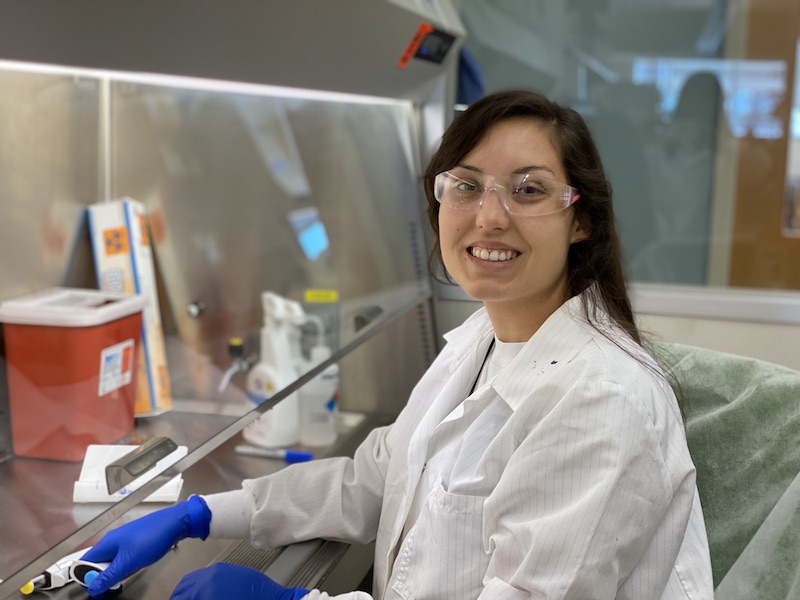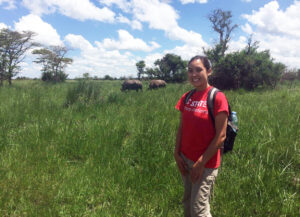CVM Student a Behind-the-Scenes Force in Coronavirus Fight

In mid-March, Elsa Sanabria was offered a job at the North Carolina State Laboratory of Public Health. A week later, she went to work testing nasal swabs for the coronavirus, samples sent by high-risk populations such as nursing care facilities or area hospitals. Sanabria then calls with the results.
By early April, she had dialed the number of a place she knew well.
Sanabria called the Henderson County Health Department to tell them about an outbreak of COVID-19 at a nursing home in Hendersonville, N.C. She noted 23 positive results.
Sanabria’s 85-year-old grandmother had once lived at that nursing home, which is about a mile or so from where her grandmother now lives with Sanabria’s father.
“I wouldn’t say it was a difficult call for me to make. I was just more concerned,” says Sanabria, who grew up in Hendersonville. “But then I called my dad and told him you really need to be careful now.”
Her reaction first comes across as surprisingly self-composed, but then you remember Sanabria is on the cusp of becoming a doctor. She begins her fourth year at the NC State College of Veterinary Medicine in August. She has a job to do right and to do right now. There’s not a lot of room for emotion.
Infectious disease research, the often tedious but undeniably important lab work, and making these kinds of calls — it has all become part of Sanabria’s passion as a future veterinarian focused on public health and epidemiology.
This lab work is grueling. Sanabria and the team have tested thousands of samples so far and the work will steadily continue as more North Carolinians are tested and the state’s pandemic response evolves.
Some of Sanabria’s co-workers are pulling 16-hour days in the lab. Before a recent rare day off, Sanabria had worked 13 hours on a Saturday and then went right back to work the next day, running samples. Extracting RNA to get the genetic material out and performing polymerase chain reactions, amplifying that genetic material to analyze. Double checking results and then triple checking them. Making those calls.
Then doing it again and again and again. Results take a few days, a very quick turnaround.
It’s a job Sanabria did not hesitate to take. She’ll be working in the lab, just up the road from the CVM, until August. The work is now a part of her clinical rotations for her final year of school.
“I guess, in maybe a weird way, this kind of work excites me. There needs to be people who are willing to do these things,” says Sanabria. “I don’t know if I would call it a ‘duty.’ But if you have the experience and you have the training — there’s a reason why someone taught you those things. Hopefully, you would use it to help others.”
Sanabria’s time at the CVM has led directly to her pivotal role in the state’s fight against COVID-19, but it’s not the type of work that motivated her to go to veterinary school in the first place.
After earning her undergraduate degree in biology from Duke University, she arrived at NC State planning to focus on small animal medicine, but decided clinical work was not for her and began to explore other options. She had never worked in a laboratory before and didn’t know much about epidemiology.
If you have the experience and you have the training — there’s a reason why someone taught you those things. Hopefully, you would use it to help others.
Then, through the CVM’s global health program, she went on a trip to Uganda. There, she saw veterinarians helping to save critically endangered mountain gorillas and working with local populations, addressing issues such as poverty and access to birth control.
An interest in global public health flowered. Soon after, Sanabria became the first student from the CVM accepted into a master’s of public health with global health emphasis program, a collaboration between the CVM and the University of North Carolina at Chapel Hill’s Gillings School of Global Public Health.
As part of that program, she worked 200 hours in the state lab’s serology unit, looking for antibodies to brucellosis, a highly contagious disease spread to people from infected animals through unpasteurized dairy products and hunting of feral swine. The lab remembered Sanabria and immediately reached out to her when it began coronavirus testing.
“I asked if I needed to send an application, but everything was happening so fast,” Sanabria says. “They were trying to get people in as fast as possible to help. So I started.”
Sanabria is the only DVM student conducting coronavirus testing in the lab. It’s a good fit for her, since her goal after graduation in 2021 is joining the Centers for Disease Control’s Epidemic Intelligence Service, a two-year postdoctoral training program.

Like it is for many, this could have easily been an emotionally trying time for Sanabria. She was prepping for her final year of veterinary school and had set up training opportunities this summer that have been cancelled.
She has also been keeping in touch with family members in China and Singapore, who have remained healthy, and checking in on grandmother, her father and his wife in Hendersonville. During one call she explained to them in Spanish how antibodies work.
And Sanabria’s husband, Ben, is on the frontline of the pandemic fight as an internal medicine doctor at a Raleigh hospital.
“These frontline workers like Ben, the nurses and the doctors, are absolutely remarkable,” says Sanabria. “I’m also so proud of all the laboratory workers across the country. The medical laboratory technicians behind the scenes, they are doing so much as well. They are working around the clock with the testing.”
She and Ben have never had a conversation about either of them not doing the work that they are doing right now. What they do is lean on each other for support, playing board games together to relax during their limited downtime.
And during her few days off, she looks for joy in the little things — watching birds, cooking, viewing cute cat videos online. Though she spends a lot of time reading about the pandemic in newspapers, Sanabria doesn’t watch the news on TV.
Then she goes back to work.
~Jordan Bartel/NC State Veterinary Medicine
- Categories:


